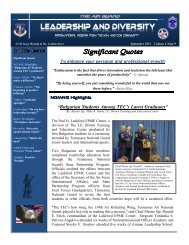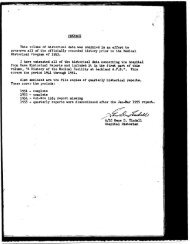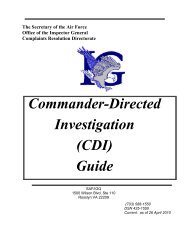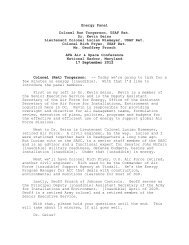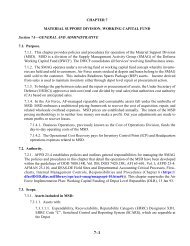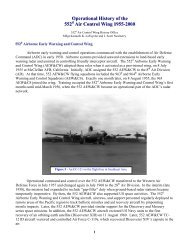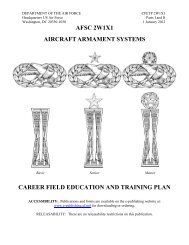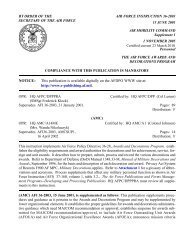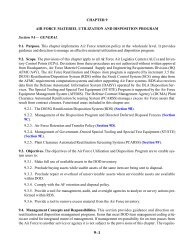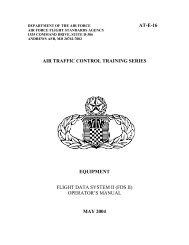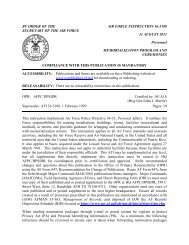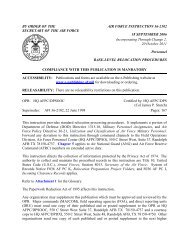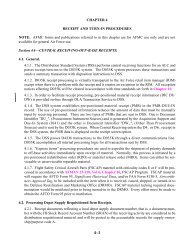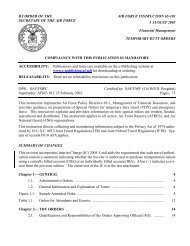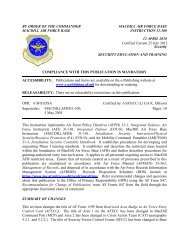MAGAZINE OF THE UNITED STATES AIR FORCE - Air Force Link
MAGAZINE OF THE UNITED STATES AIR FORCE - Air Force Link
MAGAZINE OF THE UNITED STATES AIR FORCE - Air Force Link
You also want an ePaper? Increase the reach of your titles
YUMPU automatically turns print PDFs into web optimized ePapers that Google loves.
Senior <strong>Air</strong>man<br />
Benjamin Hale, Staff<br />
Sgt. Cory Welton<br />
and Staff Sgt. Jacob<br />
Torgerson speak to<br />
the pilot of an A-10<br />
Thunderbolt during<br />
the training exercise<br />
at Camp Townsend,<br />
Ga.<br />
30<br />
Mention the term “air strike”<br />
these days and a lot of people<br />
think you’re talking about playing<br />
“Call of Duty,” a popular combat-style<br />
video game. In the game, players call<br />
in virtual air strikes on their<br />
opponents as a reward for earning a<br />
certain number of kills.<br />
But for Staff Sgt. Kenneth Walker,<br />
there’s nothing pretend about it.<br />
Calling in air strikes is what he does<br />
for a living.<br />
He’s a tactical air control party<br />
member with the 116th <strong>Air</strong> Support<br />
Operations Squadron, an <strong>Air</strong><br />
National Guard unit out of Camp<br />
Murray, Wash. TACPs are specialists<br />
that advise ground forces on aircraft<br />
employment and capabilities and<br />
direct combat aircraft onto enemy<br />
targets. They typically work in teams<br />
of two and deploy with Army combat<br />
units.<br />
www.<strong>AIR</strong>MANonline.af.mil<br />
“Basically, we’re the liaison<br />
between ground forces and aircraft,”<br />
Sergeant Walker said. “We communicate<br />
with the infantry guys and the<br />
guys in the air to get bombs on target<br />
where they’re needed.”<br />
This might sound routine, but it’s<br />
not. Being a TACP means being a<br />
highly trained, highly skilled <strong>Air</strong>man<br />
who is adaptive, quick on his feet and<br />
great at multi-tasking. Just to become<br />
a TACP and earn the coveted black<br />
beret, <strong>Air</strong>men must pass an initial<br />
skills course, a combat survival<br />
course, a basic parachutist course<br />
and an advanced special tactics<br />
course. In all, this is 32 weeks of rigorous,<br />
down-and-dirty training.<br />
“It’s definitely a lot,” Sergeant<br />
Walker said. “But it’s all stuff we<br />
need to know when we’re out there<br />
doing this for real.”<br />
When TACPs aren’t deployed and<br />
doing their job for real, they participate<br />
in exercises to practice their<br />
skills and stay certified in required<br />
tasks. The latest was the National<br />
Guard Bureau’s Joint Quarterly<br />
Training Exercise at Fort Stewart,<br />
Ga. Here, TACPs from the 116th<br />
ASOS practiced working with Army<br />
infantry units and calling in close-air<br />
support aircraft, ranging from A-10<br />
Thunderbolt IIs to F-18 Hornets and<br />
HH-60 Pave Hawk helicopters.<br />
“It’s great to work with real aircraft<br />
and see live rounds hitting targets,”<br />
said Tech. Sgt. Benjamin Santiago,<br />
a TACP with the 116th ASOS.<br />
“Simulations are fine, but the real<br />
thing is always better.”<br />
But the exercise doesn’t just give<br />
the TACPs some valuable hands-on<br />
training; it also lets them check a very<br />
important box.<br />
“We have requirements to control<br />
aircraft every 90 days and direct<br />
the release of ordnance every 180<br />
days to stay current on our certifications,”<br />
Sergeant Santiago said.



